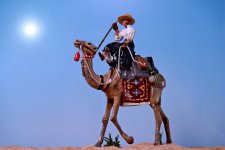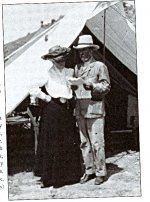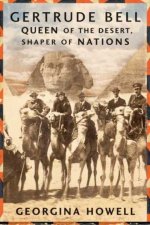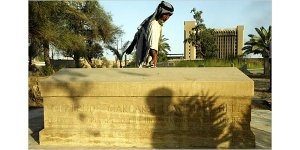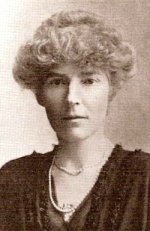You are using an out of date browser. It may not display this or other websites correctly.
You should upgrade or use an alternative browser.
You should upgrade or use an alternative browser.
Gertrude Bell (1 Viewer)
- Thread starter PolarBear
- Start date
thebritfarmer
Moderator
- Joined
- Jan 29, 2008
- Messages
- 10,446
That is a very neat figure Randy, looks like it started off with a W Britains camel.
Gertrude Bell (1868-1926)
"Queen Of the Desert"
Custom Made By
Professor William Grant: Toy Soldier Collector and Retired Professor of Biology, Williams College
Randy,
An excellent custom made figure. How does she stay seated on the camel?
I have yet to see one of the manufacturers produce a lady riding a camel.
Best Regards, Raymond
PolarBear
Major
- Joined
- Feb 24, 2007
- Messages
- 6,706
Randy,
An excellent custom made figure. How does she stay seated on the camel?
I have yet to see one of the manufacturers produce a lady riding a camel.
Best Regards, Raymond

She is permanently attached.
Gertrude spent many years in the desert of the Middle East and lived among the arabs and became a friend of Churchill and T. E. Lawrence. She was very comfortable on a camel but insisted on wearing normal female attire including her straw hat trimmed with flowers.
Randy
She is permanently attached.
Gertrude spent many years in the desert of the Middle East and lived among the arabs and became a friend of Churchill and T. E. Lawrence. She was very comfortable on a camel but insisted on wearing normal female attire including her straw hat trimmed with flowers.
Randy
Randy,
I managed to find a picture of Gertrude Bell on a camel after a search on the net.
If my identification is correct, it shows Winston Churchill on her right and T. E. Lawrence on her left.
It must have been taken in Egypt circa 1920's.
The image quality leaves much to be desired, but this was the best I could find.
Best, Raymond.
Attachments
thebritfarmer
Moderator
- Joined
- Jan 29, 2008
- Messages
- 10,446
Randy,
I managed to find a picture of Gertrude Bell on a camel after a search on the net.
If my identification is correct, it shows Winston Churchill on her right and T. E. Lawrence on her left.
It must have been taken in Egypt circa 1920's.
The image quality leaves much to be desired, but this was the best I could find.
Best, Raymond.

That would be a neat little set to own in glossy form
DMNamiot
Moderator
- Joined
- Apr 29, 2005
- Messages
- 4,336
Hi Gloss Man your ID is in fact correct.
Miss Bell was an amazing woman and must have been a giant to stand with these fellows in an era when women were kept home for the most part.
I think this is also an amazing figure!
Thanks for sharing her Randy
All the best
Dave
Miss Bell was an amazing woman and must have been a giant to stand with these fellows in an era when women were kept home for the most part.
I think this is also an amazing figure!
Thanks for sharing her Randy
All the best
Dave
PolarBear
Major
- Joined
- Feb 24, 2007
- Messages
- 6,706
If you are interested in Bell and her era you might wish to rent A Dangerous Man: Lawrence After Arabia which is very much a sequel to David Lean's Lawrence of Arabia. It is about the Paris Peace Conference after WWI with Lawrence and Bell supporting the arab cause at the conference. Ralph Fiennes is Lawrence. Unfortunately the actress who plays Bell does not look remotely like her and her part in the film is marginal. Bell was very important in the shaping of modern Iraq and when she died was buried with honors in Baghdad.
Here is a link to the film.
http://en.wikipedia.org/wiki/index.html?curid=5746114
Illustrations:
1. R. Fiennes as Lawrence
2. Lawrence & Bell in Cairo 1921
3. Bell in Turkey 1909--this is the outfit that she is wearing on the camel that was sculpted by Bill Grant
Here is a link to the film.
http://en.wikipedia.org/wiki/index.html?curid=5746114
Illustrations:
1. R. Fiennes as Lawrence
2. Lawrence & Bell in Cairo 1921
3. Bell in Turkey 1909--this is the outfit that she is wearing on the camel that was sculpted by Bill Grant
Attachments
PolarBear
Major
- Joined
- Feb 24, 2007
- Messages
- 6,706
Here is a review of Georgina Howell's book about Bell:
Gertrude of Arabia
By ROBERT F. WORTH
GERTRUDE BELL
Queen of the Desert, Shaper of Nations.
By Georgina Howell.
Illustrated. 481 pp. Farrar, Straus & Giroux. $27.50.
The British occupation of Iraq may have seemed like ancient history to the Americans who arrived in Baghdad in 2003. The Iraqis soon showed them otherwise. There were British cemeteries, British-built schools, hospitals, railroads and clubs; I once stumbled on a battered old billiard table donated in the 1920s by King George V. Above all, there was the painfully familiar record of the British struggle to build a nation. And at its center was a stiff-backed officer whom even today the Iraqis call, as if she had been a revered schoolmistress, “Miss Bell.”
Gertrude Bell was precisely the kind of colonial administrator the Americans desperately needed in 2003. Fluent in Arabic and Persian, she had spent almost a decade before World War I crisscrossing the desert, making maps and gaining the trust of tribal leaders and kings. She knew the Mesopotamian region and its people so intimately that one prominent Iraqi sheik, asked about the geographical boundaries of his tribe, told his questioner to ask Bell.
The British government hired her soon after the First World War started, recognizing that she could help turn the Arabs against Ottoman Turkey, Germany’s ally. She did far more than that. After working in Cairo with T. E. Lawrence, whose vainglorious legend she never shared, Bell virtually created modern Iraq. She drafted its borders, corralled its reluctant tribal chiefs and trained Faisal (who had never been there) to be its first king. She came to be known as Umm al Mu’mineen, or Mother of the Faithful.
Georgina Howell, a British journalist, has produced a breathless, somewhat worshipful biography of Bell. It contains almost no mention of Iraq’s recent troubles, and relegates Bell’s work in Iraq to the last third of the book — a surprising decision, given the country’s prominence in her life (and in today’s headlines). This may be because other writers have focused heavily on Bell’s Baghdad years, most notably Janet Wallach in her excellent 1996 biography, “Desert Queen.”
In fairness, Howell’s book makes clear that Bell’s whole life was extraordinary. Born into England’s sixth-richest family, she was furiously independent almost from the start. She declared her atheism as a girl, and later, her intolerance for pretension. (“I have had enough of these dinners where people say ‘I think’ all the time,” she wrote home from London. She wanted to know.) She became the first woman to get a first-class degree in modern history at Oxford, the first woman ever to travel alone in the Syrian desert, the first female officer in British military intelligence.
She also campaigned actively against female suffrage. Despite her own achievements, she accepted the prevailing Victorian view that women were not qualified to make decisions about affairs of state. And as a daughter of the establishment, she was offended by the militancy of the suffragist movement.
Howell suggests that Bell later came to regret this. She also provides fascinating examples of Bell’s struggles with her prescribed role as a woman. She was beautiful, with red hair, fine features and piercing green eyes, and she had at least two passionate love affairs (though she never married and seems to have died a virgin). But she insisted on taking roles that had been reserved for men, fighting constantly against the sexism of British officials. (“She is a remarkably clever woman with the brains of a man,” one peer wrote; others were less kind.) She also had an ill-concealed disgust for most other women, whom she saw as vain and shallow. They generally returned her condescension with scorn.
Howell has unearthed some wonderful material, and she wisely interweaves her text with plenty of quotations from Bell’s own trenchant prose. Some of the most clearsighted things ever written about Iraq (at least in English) came from the pen of Gertrude Bell.
But elsewhere Howell is something of a slave to Bell’s voluminous diaries. She needlessly documents her heroine’s Alpine mountaineering expeditions right down to what she ate for lunch on the Barre des Écrins (“bread and jam, with sardines”).
When it comes to Iraq, Howell accepts Bell’s own views too readily, both about herself and about the broader British imperial mission. At one point Howell refers in passing to “the peculiarly British notion of public service free of corruption” as if it were an unmixed gift to subject peoples.
Howell does not ask, for instance, whether Bell’s peremptory dismissal of religious leaders was wise (“How I do hate Islam!” she wrote in 1921). She favored the more secular Sunni Arabs and helped reinforce their domination over the more numerous Shiites. She argued strenuously against an independent Kurdistan. All these things could be said to have helped forge an inherently unstable polity, leading to bloodshed and war and Iraq’s present disintegration.
Still, Bell’s achievement as a nation builder was extraordinary, especially compared with the American example of the past few years. When she killed herself with sleeping pills in Baghdad in 1926, days before the inauguration of Faisal’s government, it was not because she had failed. Her work was done, the king no longer needed her and she had fallen into a deep depression. The monarchy she helped build lasted until 1958, longer than some of its creators ever expected.
Robert F. Worth, a Times correspondent, has reported on Iraq for the paper since 2003.
Gertrude of Arabia
By ROBERT F. WORTH
GERTRUDE BELL
Queen of the Desert, Shaper of Nations.
By Georgina Howell.
Illustrated. 481 pp. Farrar, Straus & Giroux. $27.50.
The British occupation of Iraq may have seemed like ancient history to the Americans who arrived in Baghdad in 2003. The Iraqis soon showed them otherwise. There were British cemeteries, British-built schools, hospitals, railroads and clubs; I once stumbled on a battered old billiard table donated in the 1920s by King George V. Above all, there was the painfully familiar record of the British struggle to build a nation. And at its center was a stiff-backed officer whom even today the Iraqis call, as if she had been a revered schoolmistress, “Miss Bell.”
Gertrude Bell was precisely the kind of colonial administrator the Americans desperately needed in 2003. Fluent in Arabic and Persian, she had spent almost a decade before World War I crisscrossing the desert, making maps and gaining the trust of tribal leaders and kings. She knew the Mesopotamian region and its people so intimately that one prominent Iraqi sheik, asked about the geographical boundaries of his tribe, told his questioner to ask Bell.
The British government hired her soon after the First World War started, recognizing that she could help turn the Arabs against Ottoman Turkey, Germany’s ally. She did far more than that. After working in Cairo with T. E. Lawrence, whose vainglorious legend she never shared, Bell virtually created modern Iraq. She drafted its borders, corralled its reluctant tribal chiefs and trained Faisal (who had never been there) to be its first king. She came to be known as Umm al Mu’mineen, or Mother of the Faithful.
Georgina Howell, a British journalist, has produced a breathless, somewhat worshipful biography of Bell. It contains almost no mention of Iraq’s recent troubles, and relegates Bell’s work in Iraq to the last third of the book — a surprising decision, given the country’s prominence in her life (and in today’s headlines). This may be because other writers have focused heavily on Bell’s Baghdad years, most notably Janet Wallach in her excellent 1996 biography, “Desert Queen.”
In fairness, Howell’s book makes clear that Bell’s whole life was extraordinary. Born into England’s sixth-richest family, she was furiously independent almost from the start. She declared her atheism as a girl, and later, her intolerance for pretension. (“I have had enough of these dinners where people say ‘I think’ all the time,” she wrote home from London. She wanted to know.) She became the first woman to get a first-class degree in modern history at Oxford, the first woman ever to travel alone in the Syrian desert, the first female officer in British military intelligence.
She also campaigned actively against female suffrage. Despite her own achievements, she accepted the prevailing Victorian view that women were not qualified to make decisions about affairs of state. And as a daughter of the establishment, she was offended by the militancy of the suffragist movement.
Howell suggests that Bell later came to regret this. She also provides fascinating examples of Bell’s struggles with her prescribed role as a woman. She was beautiful, with red hair, fine features and piercing green eyes, and she had at least two passionate love affairs (though she never married and seems to have died a virgin). But she insisted on taking roles that had been reserved for men, fighting constantly against the sexism of British officials. (“She is a remarkably clever woman with the brains of a man,” one peer wrote; others were less kind.) She also had an ill-concealed disgust for most other women, whom she saw as vain and shallow. They generally returned her condescension with scorn.
Howell has unearthed some wonderful material, and she wisely interweaves her text with plenty of quotations from Bell’s own trenchant prose. Some of the most clearsighted things ever written about Iraq (at least in English) came from the pen of Gertrude Bell.
But elsewhere Howell is something of a slave to Bell’s voluminous diaries. She needlessly documents her heroine’s Alpine mountaineering expeditions right down to what she ate for lunch on the Barre des Écrins (“bread and jam, with sardines”).
When it comes to Iraq, Howell accepts Bell’s own views too readily, both about herself and about the broader British imperial mission. At one point Howell refers in passing to “the peculiarly British notion of public service free of corruption” as if it were an unmixed gift to subject peoples.
Howell does not ask, for instance, whether Bell’s peremptory dismissal of religious leaders was wise (“How I do hate Islam!” she wrote in 1921). She favored the more secular Sunni Arabs and helped reinforce their domination over the more numerous Shiites. She argued strenuously against an independent Kurdistan. All these things could be said to have helped forge an inherently unstable polity, leading to bloodshed and war and Iraq’s present disintegration.
Still, Bell’s achievement as a nation builder was extraordinary, especially compared with the American example of the past few years. When she killed herself with sleeping pills in Baghdad in 1926, days before the inauguration of Faisal’s government, it was not because she had failed. Her work was done, the king no longer needed her and she had fallen into a deep depression. The monarchy she helped build lasted until 1958, longer than some of its creators ever expected.
Robert F. Worth, a Times correspondent, has reported on Iraq for the paper since 2003.
Attachments
Hi Gloss Man your ID is in fact correct.
Miss Bell was an amazing woman and must have been a giant to stand with these fellows in an era when women were kept home for the most part.
I think this is also an amazing figure!
Thanks for sharing her Randy
All the best
Dave
Hello Dave,
Thanks very much for the ID confirmation on the photograph.
Indeed, Miss Bell was way ahead of her time for women of her generation.
Hi Randy,
Thanks for starting this valuable thread.
Here is a link to website showing a very nice oil painting of her house in Baghdad.
http://www.gac.culture.gov.uk/search/Object.asp?object_key=12716
Best, Raymond.
PolarBear
Major
- Joined
- Feb 24, 2007
- Messages
- 6,706
Desert Queen, The Extraordinary Life of Gertrude Bell
Janet Wallach
BIOGRAPHY/MEMOIR • 2005 • PAPER • 419 PAGES
A lively biography of Gertrude Bell, a Middle East adventuress, and formidable personality in colonial Britain. A contemporary of Lawrence of Arabia and friend to Arab leaders, Bell's influence on Middle Eastern politics made her the "most powerful woman in the British Empire in the years after World War I." (MDE37, $15.95)
Janet Wallach
BIOGRAPHY/MEMOIR • 2005 • PAPER • 419 PAGES
A lively biography of Gertrude Bell, a Middle East adventuress, and formidable personality in colonial Britain. A contemporary of Lawrence of Arabia and friend to Arab leaders, Bell's influence on Middle Eastern politics made her the "most powerful woman in the British Empire in the years after World War I." (MDE37, $15.95)
Attachments
PolarBear
Major
- Joined
- Feb 24, 2007
- Messages
- 6,706
Bill Grant has suggested 2 actresses that would have been ideal to portray Bell in looks, philosophy and temperament:
Katherine Hepburn
Emma Thompson
I agree with these choices. Here are Bell and Emma Thompson in a scene from Fortunes of War, part of which is set in the Middle East.
Katherine Hepburn
Emma Thompson
I agree with these choices. Here are Bell and Emma Thompson in a scene from Fortunes of War, part of which is set in the Middle East.
Attachments
Harrytheheid
Banned
- Joined
- Apr 19, 2007
- Messages
- 4,672
I thought this was an update of an old thread concerning Miss Bell. Turns out its a new one - and none the less facinating for that.
Keep it up guys, along with Lady Hester, Miss Bell was an icon of a long-ago Middle East.
Thanks
H
Keep it up guys, along with Lady Hester, Miss Bell was an icon of a long-ago Middle East.
Thanks
H
Users who are viewing this thread
Total: 2 (members: 0, guests: 2)


